Centauri Dreams
Imagining and Planning Interstellar Exploration
Teegarden’s Star b: A Habitable Red Dwarf Planet?
I have a number of things to say about Teegarden’s Star and its three interesting planets, but I want to start with the discovery of the star itself.
Here we have a case of a star just 0.08 percent as massive as the Sun, an object which is all but in brown dwarf range and thus housing temperatures low enough to explain why, despite its proximity, it took until 2003 to find it.
Moreover, conventional telescopes were not the tools of discovery but archival data. Bonnard Teegarden (NASA GSFC) dug into archival data from the Near-Earth Asteroid Tracking program, surmising that there ought to be more small stars near us than we were currently seeing. The data mining paid off, and then paid off again when the team looked at the Palomar Sky Survey of 1951. This was a team working without professional astronomers and telescopes.
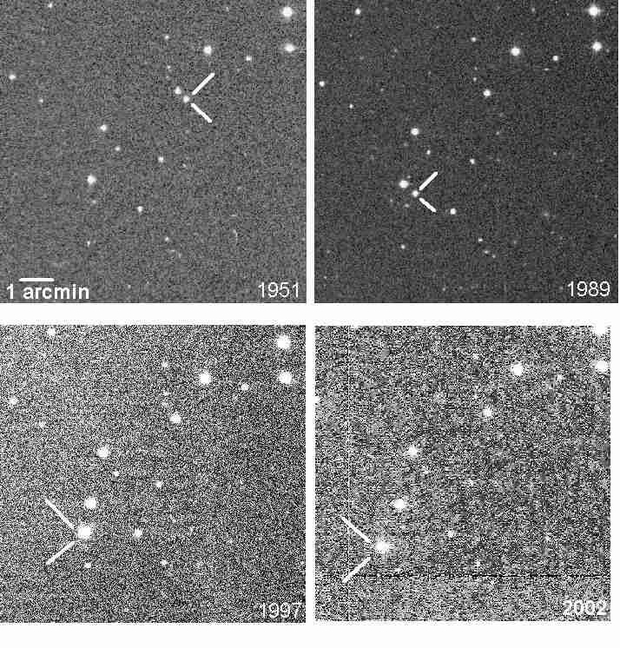
Image: Teegarden’s Star was subsequently identified in astronomical images taken more than 50 years ago. Credit: Palomar Sky Survey / SolStation.com.
That it took until 2019 to announce evidence of planets reflects the fact that for some time, we had trouble even coming up with a workable parallax reading, one that finally produced a distance of 12.497 light years. There are no transits at Teegarden’s Star, so the discovery data on the first two planets came through radial velocity studies conducted with the CARMENES instrument at the Calar Alto Observatory in Spain. In 2024 a third planet was found, likewise by RV.
Teegarden’s Star compels attention because of those planets, and in particular Teegarden’s Star b, which orbits just inside the habitable zone with an orbit lasting about five days. Its minimum mass, calculated from the radial velocity data, is 1.05 times that of Earth, but recall that because of the limitations of the RV method, we can’t know the orbital inclination of a world that is likely larger. The primary is relatively quiescent by red dwarf standards, and indeed produces flares that would not be problematic if planet b retained an atmosphere.
That last note is important, because the whole question of how long the planets of young red dwarfs retain an atmosphere is crucial. Teegarden’s Star is about eight billion years old and, as I mention, comparatively calm. But young red dwarfs can spit out enormous flares and present serious problems for atmospheric gases, to the point that the atmospheres may be depleted or destroyed altogether. We need to come to grips with the possibility that red dwarfs may simply be inhospitable to life, a notion skillfully dissected by David Kipping in a recent paper that I plan to address in the near future.
For now, though, let’s take a brief look at a new paper from Ryan Boukrouche and Rodrigo Caballero (Stockholm University) and Neil Lewis (University of Exeter). The authors tackle climate and potential habitability of Teegarden’s Star b, noting that its proximity puts it in the catalog for study by next-generation observatories. The team uses a three-dimentional global climate model (GCM) to study habitability, including position in the habitable zone and the question of surface climate if there is an Earth-like atmosphere.
The interest in Teegarden’s Star draws not only from its Earth-mass planets – which Boukrouche and colleagues see as prime fodder for future telescopes like the ESO’s Extremely Large Telescope and its Planetary Camera and Spectrograph – but the effect of flare activity on atmospheres. The authors assume that Teegarden’s Star b is tidally locked given its tight orbit (4.9 days) around the primary. They consider values for surface albedo which approximate first an ocean-dominated surface and then a surface dominated by land masses. Here the discussion reaches this conclusion: “Although the sensitivity to surface albedo is… relatively small, it illustrates that the habitable zone does depend on factors intrinsic to the planet, not just on orbital parameters.”
The results indicate that this intriguing planet may be habitable under these atmosphere assumptions, but if so, it is still close to the inner edge of the habitable zone. Indeed, of two different orbital distances chosen from earlier papers investigating this planet, one produces a runaway greenhouse effect that would prevent the presence of liquid water on the surface. Fittingly, the authors are sensitive to the fact that the habitability question hinges upon the configuration of their models. Citing studies of TRAPPIST-1, they note this:
…different GCMs configured to simulate the same planet can produce a range of climates and circulation regimes (presumably owing to differences between the parameterizations included in each model). For example, models capable of consistently simulating non-dilute atmospheres may explore the possibility that under a range of instellation values, the planet’s atmosphere might be in a moist greenhouse state (Kasting et al. 1984) instead of a runaway, where water builds up enough that the stratosphere becomes moist, driving photodissociation and loss of water to space.
Installation is critical. The classic problem: We need more data, which can only be supplied by future telescopes. Teegarden’s Star remains highly interesting, but if we have yet to nail down the orbital distance of a planet so close to the inner edge of the habitable zone, we can’t yet make the call on how much light and heat this planet receives. And the authors themselves point out that the origins of nitrogen on Earth are not completely understood, which makes guesses at its abundance in other worlds’ atmospheres problematic.

Image: Even in our local ‘neighborhood,’ the data on Earth-mass planets is paltry, and our investigations rely heavily on simulations with values plugged in to gauge the possibilities. New instrumentation will help but it’s sobering to realize how far we are from making the definitive call on such basic issues as whether a given rocky world even has an atmosphere. Image credit: Inductiveload – self-made, Mathematica, Inkscape. Via Wikimedia Commons.
Let me just suggest that this is where we are right now when it comes to key questions about life around nearby stars. Plugging in the necessary data on any system takes time and, when it comes to Earth-mass planets around red dwarfs, the kind of instrumentation that is still on the drawing boards or in some cases under construction. Given all that, we’re going to have quite a few years ahead of us in which we’re constructing theories to explain what we see without the solid data that will help us choose among myriad alternatives.
The paper is Boukrouche, Caballero & Lewis, “Near the Runaway: The Climate and Habitability of Teegarden’s Star b,” accepted at The Astrophysical Journal Letters. Preprint available.

A Dark Object or ‘Dark Matter’?
We are fortunate enough to be living in the greatest era of discovery in the history of our species. Astronomical observations through ever more sensitive instruments are deepening our view of the cosmos, and just as satisfyingly, forcing questions about its past and uncertain future. I’d much rather live in a universe with puzzling signs of accelerated expansion (still subject to robust debate) and evidence of matter that does not interact with the electromagnetic force (dark matter) than in one I could completely explain.
Thus the sheer enjoyment of mystery, a delight accented this morning as I contemplate the detection of a so-called ‘dark object’ of unusually low mass. Presented in both Nature Astronomy and Monthly Notices of the Royal Astronomical Society, the papers describe an object that could only be detected through gravitational lensing, a familiar exoplanet detection tool that reshapes light passing near it. With proper analysis, the nature of the distortion can produce a solid estimate of the amount of matter involved.
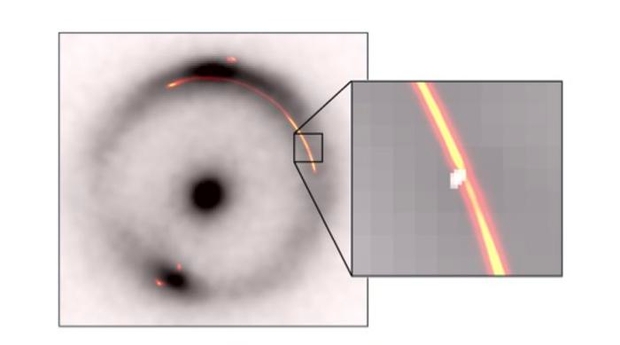
Image: The black ring and central dot show an infrared image of a distant galaxy distorted by a gravitation lens. Orange/red shows radio waves from the same object. The inset shows a pinch caused by another, much smaller, dark gravitational lens (white blob). Credit: Devon Powell, Max Planck Institute for Astrophysics.
We wouldn’t have any notion of dark matter were it not for the fact that while we cannot see it via photons, it does interact with gravity, and was indeed first hypothesized because of the anomalous rotation of distant galaxies. Fritz Zwicky was making conjectures about the Coma Cluster of galaxies way back in the 1930s, while Jan Oort pondered mass and observed motion of the Milky Way’s stars in the same period. It would be Vera Rubin in the 1970s who reawakened the study of dark matter, with her observations of stellar rotation around galactic centers, which proved to be too fast to be explained without additional mass, meaning mass that we currently couldn’t see.
The present work involves the Green Bank Telescope in West Virginia, the Very Long Baseline Array in Hawaii and the European Very Long Baseline Interferometric Network, which creates a virtual telescope the size of Earth. Heavy-hitter instrumentation for sure, and all of it necessary to spot the infinitesimal signals of the gravitational lensing created by this object.
Devon Powell (Max Planck Institute for Astrophysics, Germany is lead author of the paper in Nature Astronomy:
“Given the sensitivity of our data, we were expecting to find at least one dark object, so our discovery is consistent with the so-called ‘cold dark matter theory’ on which much of our understanding of how galaxies form is based. Having found one, the question now is whether we can find more and whether the numbers will still agree with the models.”
An interesting question indeed. It raises the question of whether dark matter can exist in regions without any stars, and offers at least a tentative answer. Or will we subsequently learn that this object is something a bit more prosaic, a compact and inactive dwarf galaxy from the very early universe? The authors point out that this is the lowest mass object ever found through gravitational lensing, which points to the likelihood that future searches will uncover other examples. We’re clearly at the beginning of the study of dark matter and remain ignorant of its makeup, so we can expect this work to continue. New lens-modeling techniques and datasets taken at high angular resolution provide the tools needed to make images more detailed than any before taken of the high-redshift universe and gravitationally lensed objects.
From the Powell et al. paper:
Strong gravitational lensing offers a powerful alternative pathway for studying low-mass objects with little to no EM luminosity. A spatially extended source in a galaxy-scale strong lens system acts as a backlight for the gravitational landscape of its lens galaxy, revealing low-mass perturbers through their gravitational effects alone. Furthermore, lens galaxies typically lie in the redshift range 0.2 ≲ z ≲ 1.5, which means that low-mass, low-luminosity objects can be detected and studied across cosmic time. To date, observations of galaxy-scale lenses with resolved arcs have been used to detect three low-mass perturbers: discovered by Hubble, Keck and ALMA…[E]xpanding the mass range that we can robustly probe necessitates that we use strong lens observations at the highest possible angular resolution.
The first paper is Powell et al., “A million-solar-mass object detected at a cosmological distance using gravitational imaging,” Nature Astronomy 4 March 2025. Full text. The second paper is McKean et al., “An extended and extremely thin gravitational arc from a lensed compact symmetric object at redshift of 2.059.” Monthly Notices of the Royal Astronomical Society Vol. 544, Issue 1 (November, 2025), L24-30. Full text.

Solar Sails for Space Weather
A new paper dealing with solar phenomena catches my eye this morning. Based on work performed at the University of Michigan, it applies computer modeling to delve into what we can call ‘structures’ in the solar wind, which basically means large-scale phenomena like coronal mass ejections (CMEs) and powerful magnetic flux ‘ropes’ that are spawned by the interaction of a CME and solar wind plasma. What particularly intrigues me is a mission concept that the authors put to work here, creating virtual probes to show how our questions about these structures can be resolved if the mission is eventually funded.
More on that paper in a minute, but first let me dig into the mission’s background. It has been dubbed Space Weather Investigation Frontier, or SWIFT. Originally proposed in 2023 in Frontiers in Astronomy and Space Sciences and with a follow-up in 2025 in Acta Astronautica (citations below), the mission is the work of Mojtaba Akhavan-Tafti and collaborators at the University of Michigan, Les Johnson (NASA MSFC) and Adam Szabo (NASA GSFC). The latter is a co-author on today’s paper., which studies the use of the SWIFT probes to study large-scale solar activity.
What SWIFT would offer is the ability to monitor solar activity at a new level of detail through multiple space weather stations. A solar sail is crucial to the concept, for one payload must be placed closer to the Sun than the L1 Lagrange point, where gravitational equilibrium keeps a satellite in a fixed position relative to Sun and Earth. Operating closer to the Sun than L1 requires a solar sail that can exactly balance the momentum of solar photons and the gravitational force pulling it inward. If this ‘statite’ idea sounds familiar, it’s because the work grows out of NASA’s Solar Cruiser sail, a quadrant of which was successfully deployed last year on Earth. We’ve discussed Solar Cruiser in relation to the study of the Sun’s high latitudes using non-Keplerian orbits.
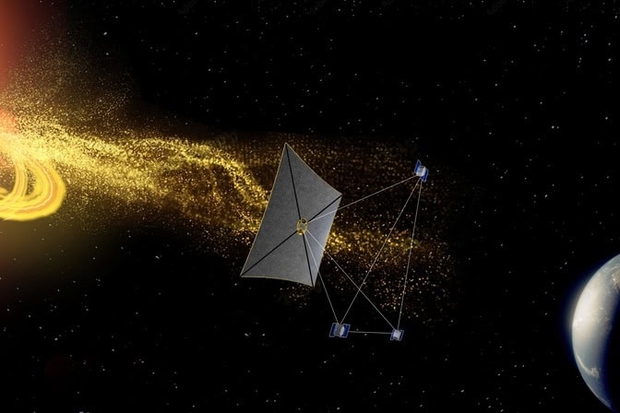
Image: An artist’s rendering of the spacecraft in the SWIFT constellation stationed in a triangular pyramid formation between the sun and Earth. A solar sail allows the spacecraft at the pyramid’s tip to hold station beyond L1 without conventional fuel. Credit: Steve Alvey, University of Michigan.
The SWIFT mission, unlike Solar Cruiser, would consist of four satellites – one of them using a large sail, and the other three equipped for chemical propulsion. Think of a triangular pyramid, with the sail-equipped probe at the top and the other three probes at each corner of the base in a plane around L1. Most satellites tracking Solar activity are either in low-Earth orbit or geosynchronous orbit, while current assets at the L1 point (WIND, ACE, DSCOVR, and IMAP) can offer up to 40 minutes of advance warning for dangerous solar events.
SWIFT would buy us more time, which could be used to raise satellite orbits that would be compromised by the increased drag caused by atmospheric heating during a geomagnetic storm. Astronauts likewise would receive earlier warning to take cover. But the benefits of this mission design go beyond small increases in alert time. With an approximate separation of up to 1 solar radius, the SWIFT probes would be able to extract data from four distinct vantage points.
Designed to fit the parameters of a Medium-Class Explorer mission, SWIFT is described in the Johnson et al. paper in Acta Astronautica as a ‘hub’ spacecraft (sail-equipped) with three ‘node’ spacecraft, all to be launched aboard a Falcon 9. The craft will fly “in an optimized tetrahedron constellation, covering scales between 10 and 100s of Earth radii.” A bit more from the paper:
This viewing geometry will enable scientists to distinguish between local and global processes driving space weather by revealing the spatial characteristics, temporal evolution, and geo-effectiveness of small-to meso-scale solar wind structures and substructures of macro-scale structures, such as interplanetary coronal mass ejections (ICMEs) and stream interaction regions (SIRs). In addition, real time measurements of earth-bound heliospheric structures from sub-L1 will improve our current forecasting lead-times by up to 35 percent.
Looking now at the paper “High-resolution Simulation of Coronal Mass Ejection–Corotating Interaction Region Interactions: Mesoscale Solar Wind Structure Formation Observable by the SWIFT Constellation,” with lead author W. B. Manchester, the scale of the potential SWIFT contribution becomes clear::
The radial and longitudinal spacecraft separations afforded by the SWIFT constellation enable analyses of the magnetic coherence and dynamics of meso- to large-scale solar wind structures… The main advantage of the tetrahedral constellation is its ability to distinguish between a structure’s spatial and temporal variations, as well as their orientations.
Coronal mass ejections are huge outbursts of plasma whose injections into the solar wind form mesoscale structures with profound implications for Earth. Magnetic field interactions can produce geomagnetic storms that play havoc with communications and navigation systems. The effects show up in unusual places. Sudden changes in Earth’s atmosphere can affect satellite orbits. On the ground, this particular study, out of the University of Michigan, cites a 2024 geomagnetic event that created large financial losses in agricultural areas in the US Midwest by crippling navigation systems on farm-belt tractors.
Mojtaba Akhavan-Tafti, co-author of the paper, notes the need for more precise detection of this phenomenon:
“If there are hazards forming out in space between the sun and Earth, we can’t just look at the sun. This is a matter of national security. We need to proactively find structures like these Earth-bound flux ropes and predict what they will look like at Earth to make reliable space weather warnings for electric grid planners, airline dispatchers and farmers.”
Flux ropes, between 3,000 and 6 million miles wide, are hard to recreate in current CME simulations and prove too large for existing modeling of magnetic field interactions with plasma. The new study produces a simulation that probes the phenomenon, showing that these ‘ropes’ are produced as the coronal mass ejection moves outward through solar wind plasma, and can form vortices interacting with different streams of solar wind. The authors compare them to tornadoes, noting that existing space weather-monitoring spacecraft are not always able to detect their formation. SWIFT will be able to spot them.
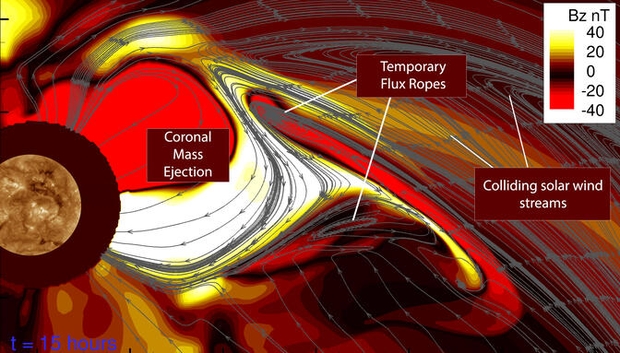
Image: A computer-generated image shows where rotating magnetic fields form at the edges of a coronal mass ejection 15 hours after a solar eruption. The coronal mass ejection is the large bubble extending from the sun at the left edge of the image. Two streams of plasma extend from the edge of the coronal mass ejection as it hits neighboring streams of fast and slow solar wind. Shades of red and yellow depict the strength and orientation of the plasma’s magnetic field (labeled “Bz” in the figure legend). Shades of red represent plasma that could trigger geomagnetic storms if it hits Earth, while shades of yellow represent plasma with a strong, positive orientation. The red-brown circle around the sun shows the area not covered by the simulation, about ten million miles wide. ILLUSTRATION: Chip Manchester, University of Michigan.
This is fascinating research into a topic with near-term ramifications, a matter of planetary defense that we can take steps to resolve soon, although as always we await funding decisions. In the larger perspective, here is another way sails can be employed for purposes no other propulsion method could achieve. Future sails could use these methods to ‘hover’ over the Sun’s polar regions. Moreover, close observation of space weather changes near the Earth has much to tell us about future mission concepts that would harness solar wind plasma to drive a magsail or enable an electric sail to reach high velocities.
ADDENDUM: Alex Tolley tracked down a paper I hadn’t seen on SWIFT, available here. This may be helpful in understanding the full mission concept.
The 2023 paper on SWIFT is Akhavan-Tafti et al., “Space weather investigation Frontier (SWIFT),” Frontiers in Astronomy and Space Sciences Vol 10 (2023), 1185603 (abstract). The 2025 paper is Johnson et al., “Space Weather Investigation Frontier (SWIFT) mission concept: Continuous, distributed observations of heliospheric structures from the vantage points of Sun-Earth L1 and sub-L1,” Acta Astronautica Vol. 236 (November 2025), 684=691 (abstract). The paper on solar activity as a target for SWIFT is Manchester et al., “High-resolution simulation of CME-CIR interactions: small- to mesoscale solar wind structure formation observable by the SWIFT constellation,” The Astrophysical Journal Vol. 992 No. 1 (2025), 51 (full text).

Rogue Planets: A Stellar Infancy?
How exoplanets emerge from circumstellar disks has always intrigued me, and many open questions remain, including the precise mechanisms behind the fast growth of gas giants. When the topic swings to so-called ‘rogue’ planets, formation issues seem to be the same, since we’ve assumed most such worlds have been ejected from a host system through gravitational interactions. But is there another formation path? We are learning that rogue planets are capable of feats not seen in conventional star/planet systems.
Research out of the National Institute for Astrophysics (INAF) in Italy is provocative. Using data from the European Southern Observatory’s Very Large Telescope (VLT) as well as the James Webb Space Telescope, Víctor Almendros-Abad (Astronomical Observatory of Palermo) and an international team of astronomers have found a large rogue planet (five to ten times as massive as Jupiter) that continues to form, accreting gas and dust from a surrounding cloud. No circumstellar disk required here. Growth comes in waves, now about eight times faster than just a few months before. We’re talking about accreting six billion tonnes per second, and a growth phenomenon hitherto restricted to young stars not yet on the Main Sequence.
Given this, we might consider Almendros-Abad’s comment an understatement:
“People may think of planets as quiet and stable worlds, but with this discovery we see that planetary-mass objects freely floating in space can be exciting places.”
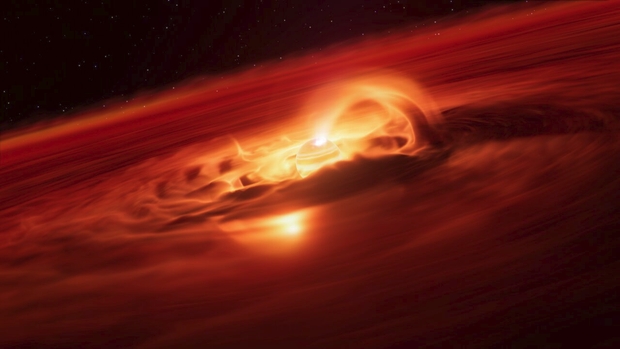
Image: Astronomers have identified an enormous ‘growth spurt’ in a so-called rogue planet. Unlike the planets in our Solar System, these objects do not orbit stars, free-floating on their own instead. The new observations, made with the European Southern Observatory’s Very Large Telescope (ESO’s VLT), reveal that this free-floating planet is eating up gas and dust from its surroundings at a rate of six billion tonnes a second. This is the strongest growth rate ever recorded for a rogue planet, or a planet of any kind, providing valuable insights into how they form and grow. Credit: ESO.
The rogue planet in question is dubbed Cha 1107-7626, some 620 light years out in the direction of the constellation Chamaeleon. This is one of those deep southern sky constellations announced in the early 17th Century by Dutch navigators. How they ever found a chamaeleon shape in its dim stars is beyond me, but this niche of the sky holds, interestingly enough, one of the closest star-forming regions to the Sun. It is now home to what is considered the strongest accretion event on record for an object with the mass of a planet.
So we have an instance of a rogue planet that behaves in some respects like a star, with the current burst of accretion mediated by magnetic activity. Strong hydrogen alpha (Hα) emission picked up in the spectroscopic data is considered “a hallmark for channeled, magnetospheric accretion,” and the size of the change in the hydrogen lines is what flags the dramatic increase in accretion rate. Finding it in a planet-mass object is highly unusual. A major tool for astronomers, the hydrogen alpha line is emitted when an electron moves from the third lowest to the second lowest energy state in the hydrogen atom.
Looking into the paper (just published in The Astrophysical Journal Letters, I learned that bursts like this are well studied in young stars:
In particular, such events can have a significant effect on chemical and physical evolution of the disk (P. Ábrahám et al. 2009; S. A. Smith et al. 2025), and potentially on the early stages of planet formation. Our target is the lowest mass object observed thus far that is going through an accretion burst, and by far the lowest in the EXor category [young stars pre-Main Sequence]. Detailed studies of accretion variability have in the past helped to illuminate the interactions between young stellar objects and their disks, including the role of magnetic fields. Similarly, the observations presented here provide a glimpse into the nature of accretion in planetary-mass objects.
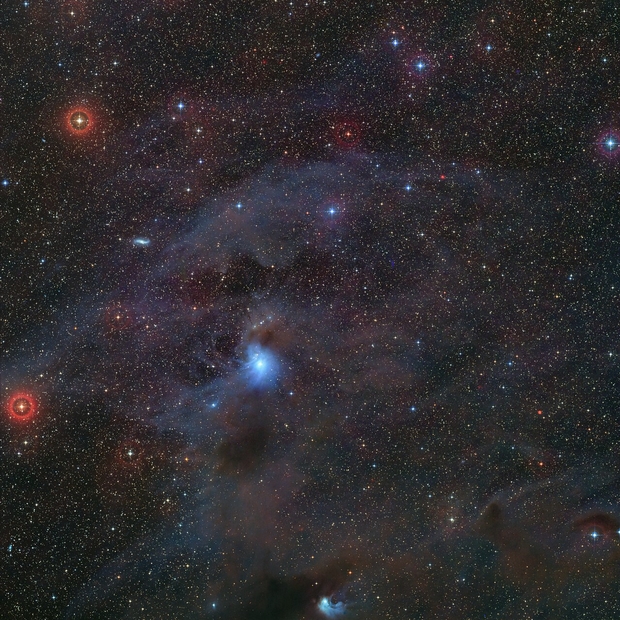
Image: This visible-light image, part of the Digitized Sky Survey 2, shows the position in the sky of the rogue planet Cha 1107-7626. The planet (not visible here) is located exactly at the centre of the frame. Credit: ESO/ Digitized Sky Survey 2.
The belief that rogue planets are invariably the result of ejections from a planetary system is challenged by these findings. From my reading of this paper, we seem to be looking at a ‘star-like’ formation of a gas giant through accretion, hinting at a variety of formation scenarios in free-floating worlds. Surely we will find more, but for now I can see why the authors call Cha1107-7626 “the poster child for disk accretion in the planetary-mass domain.”
The paper is Almendros-Abad et al., “Discovery of an Accretion Burst in a Free-Floating Planetary-Mass Object,” Volume 992, Number 1 (2 October 2025), L2 (full text).

A Potential Martian Biosignature
I’ve long maintained that we’ll find compelling biosignatures on an exoplanet sooner than we’ll find them in our own Solar System. But I’d love to be proven wrong. The recent flurry of news over the interesting findings from the Perseverance rover on Mars is somewhat reminiscent of the Clinton-era enthusiasm for the Martian meteorite ALH8001. Now there are signs, as Alex Tolley explains below, that this new work will prove just as controversial. Biosignatures will likely be suggestive rather than definitive, but Mars is a place we can get to, as our rovers prove. Will Perseverance compel the sample return mission that may be necessary to make the definitive call on life?
by Alex Tolley

Overview of jezero Crater and sample site in article. Credit NASA/MSSS/USGS.
On September 10, 2025, Nature published an article that got wide attention. The authors claimed that they had discovered a possible biosignature on Mars. If confirmed, they would have won the race to find the first extraterrestrial biosignature. Exciting!
One major advantage of detecting a biosignature in our system is that we can access samples and therefore glean far more information than we can using spectroscopic data from an exoplanet. This will also reduce the ambiguity of simpler atmospheric gas analyses that are all we can do with our telescopes at present.
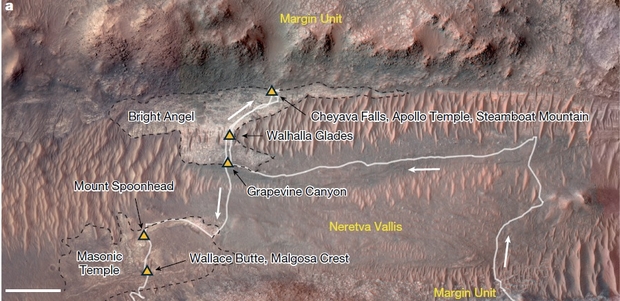
Figure 1. Perseverance’s path through Neretva Vallis and views of the Bright Angel formation. a, Orbital context image with the rover traverse overlain in white. White line and arrows show the direction of the rover traverse from the southern contact between the Margin Unit and Neretva Vallis to the Bright Angel outcrop area and then to the Masonic Temple outcrop area. Labelled orange triangles show the locations of proximity science targets discussed in the text. b, Mastcam-Z 360° image mosaic looking at the contact between the light-toned Bright Angel Formation (foreground) and the topographically higher-standing Margin Unit from within the Neretva Vallis channel. This mosaic was collected on sol 1178 from the location of the Walhalla Glades target before abrasion. Upslope, about 110 m distant, the approximate location of the Beaver Falls workspace (containing the targets Cheyava Falls, Apollo Temple and Steamboat Mountain and the Sapphire Canyon sample) is shown. Downslope, about 50 m distant, the approximate location of the target Grapevine Canyon is also shown. In the distance, at the southern side of Neretva Vallis, the Masonic Temple outcrop area is just visible. Mastcam-Z enhanced colour RGB cylindrical projection mosaic from sol 1178, sequence IDs zcam09219 and zcam09220, acquired at 63-mm focal length. A flyover of this area is available at https://www.youtube.com/watch?v=5FAYABW-c_Q. Scale bars (white), 100 m (a), 50 m (b, top) and 50 cm (b, bottom left). Credit: NASA/JPL-Caltech/ASU/MSSS.
Let’s back up for context. The various rover missions to Mars have proceeded to determine the history of Mars. From the Pathfinder mission starting in 1996, the first mission since the two 1976 Viking landers, the various rovers from Soujourner (1997), Spirit & Opportunity (2004), Curiosity (2012), and now Perseverance (2021), have increased the scope of their travels and instrument capabilities. NASA’s Perseverance rover was designed to characterize environments and look for signs of life in Jezero Crater, a site that was expected to be a likely place for life to have existed during the early, wet phase of a young Mars. The crater was believed to be a lake, fed by water running into it from what is now Neretva Vallis, and signs of a delta where the ancient river fed into the crater lake are clear from the high-resolution orbital images. Perseverance has been taking a scenic tour of the crater, making stops at various points of interest and taking samples. If there were life on Mars, this site would have both flowing water and a lake, with sediments that create a variety of habitats suitable for prokaryotic life, like the contemporary Earth.
Perseverance had taken images and samples of a sedimentary rock formation, which they called Bright Angel. The work involved using the Scanning Habitable Environments with Raman and Luminescence for Organics and Chemicals (SHERLOC) instrument to obtain a Raman UV spectrum of rock material from several samples. The authors claimed that they had detected 2 reduced iron minerals, greigite and vivianite, and organic carbon. The claim is that these have been observed in alkaline environments on Earth due to bacteria, and therefore prove to be a biosignature of fossil life. The images showed spots (figure 2) which could possibly be the minerals formed by the metabolism of anaerobic bacteria, reducing sulfur and iron for energy. The organic carbon in the mudstone rock matrix is the fossil remains of the bacteria living in the sediments.
Exciting, no? Possible proof that life once existed on Mars. The authors submitted a paper to Nature with the title, “Detection of a Potential Biosignature by the Perseverance Rover on Mars“. The title was clearly meant to catch the scientific and popular attention. At last, NASA’s “Follow the Water” strategy and exploration with their last rover equipped to detect biosignatures had found evidence of fossil life on Mars. It might also be a welcome boost for NASA’s science missions, currently under funding pressure from Congress.
Then the peer review started, and the story seemed less strong. Just as 30 years ago, when the announcement from the White House by the US president, Bill Clinton claimed that a Martian meteorite retrieved from the Antarctic, ALH8001, was evidence of life on Mars proved very controversial. Notably, slices of that meteorite viewed under an electron microscope showed images of what might have been some forms of bacteria. These images were seen around the world and were much discussed. The consensus was that the evidence was not unambiguous, with even the apparent “fossil bacteria” being explained as natural mineral structures.
Well, the new paper created one of the longest peer review documents I have ever read. Every claimed measurement and analysis was questioned, including the interpretation. The result was that the paper was published as the much drier “Redox-driven mineral and organic associations in Jezero Crater, Mars”. There are just 3 uses of the term biosignatures, each prefaced with the term “potential”, and the null hypothesis of abiotic origin emphasized as well. One of the three peer reviewers even wanted Nature to reject the paper, based on what might be another ALH8001 fiasco. A demand, too far.
What were the important potential biosignature findings?
Organisms extract energy from molecules via electron transfer. This often results in the compounds becoming more reduced. For example, sulfur-reducing bacteria convert sulfates (SO4) to sulfide (S). Iron may be reduced from its ferric (Fe3+) state to its ferrous (Fe2+) state. Two minerals that are often found reduced as a result of bacterial energy extraction are greigite Fe2+Fe3+2S4] and vivianite [Fe2+3(PO4)2·8H2O]. On Earth, these are regarded as biosignatures. In addition, unidentified carbon compounds were associated with these 2 minerals. The minerals were noticed as spots on the outcrop and identified with the Planetary Instrument for X-ray Lithochemistry (PIXL), which can identify elements via X-ray spectroscopy. The SHERLOC instrument identified the presence of carbon in association with these minerals.

Figure 2. An image of the rock named “Cheyava Falls” in the “Bright Angel formation” in Jezero crater, Mars, collected by the WATSON camera onboard the Mars 2020 Perseverance rover. The image shows a rust-colored, organic matter in the sedimentary mudstone sandwiched between bright white layers of another composition. The small dark blue/green to black colored nodules and ring-shaped reaction fronts that have dark rims and bleached interiors are proposed to be potential biosignatures. Credit: NASA/JPL-Caltech/MSSS.
To determine whether the carbon associated with the greigite and vivianite was organic or inorganic, the material was subjected to ultraviolet rays. Organic carbon bonds, especially carbon-carbon bonds, will respond to specific wavelengths by vibrating, like sound frequencies can resonate and break wine glasses. Raman spectroscopy is the technique used to detect the resonant vibrations of types of carbon bonds, particularly specific arrangements of the atoms and their bonds that are common in organic carbon. The spectroscopic data indicated that the carbon material was organic, and therefore possibly from decayed organisms. This would tie together the findings of the carbon and the 2 minerals as a composite biosignature. However, the reviewers also questioned the interpretation of the Raman spectrum.. The sp2 carbon bonds (120 degrees) seen in aromatic 6-carbon rings, in graphene, graphite, and commonly in biotic compounds, should show both a G-band (around 1600 cm-1) and a D-band (around 2700 cm-1), yet the spectrum only clearly showed the G-band. Did this imply that the organic carbon may not have been found? The reviewers also questioned why the biological explanation was favored over an abiotic one. No one questioned the greigite and vivianite findings, other than that they are not exclusively associated with anaerobic bacterial metabolism.

Figure 3 – Raman spectrum with interpolated curves to highlight the G-band in the 4 samples taken at the location.
So what to make of this? Clearly, the authors backed down on their more positive interpretation of their findings as a biosignature.
What analyses would we want to do on Earth?
Assuming the samples from Perseverance are eventually retrieved and returned to Earth, what further analysis would we want to do to increase our belief that a biosignature was discovered?
A key analysis would be to analyze the carbon deposits. The Raman UV spectra indicate that the carbon is organic, which is almost a given. You may recall that the private MorningStar mission to Venus will do a similar analysis but use a laser-induced fluorescence that detects aromatic rings [1]. Neither of these techniques can distinguish between abiotic and biogenic carbon. The carbon may even be in the form of common polycyclic aromatic hydrocarbons (PAH), a form that is ubiquitous and is easily formed, especially with heat.
One useful approach to distinguish the source of the carbon is to measure the isotopic ratios of the 2 stable carbon isotopes, carbon-12 and carbon-13. Living organisms favor the lighter carbon-12, and therefore, the C13/C12 ratio is reduced when the carbon is from living organisms. This must be compared to known abiotic carbon to confirm its source. This analysis requires a mass spectrometer, which was not included with the Perseverance instrument pack.
The second approach is to analyze the carbon compounds. Gas chromatography followed by infrared spectroscopy is used to characterize the compounds. Life restricts the variety of compounds compared to random reactions, and can be compared to expectations based on Assembly Theory [2], although exposure to UV and particle radiation for billions of years may make the composition of the carbon more random.
Lastly, if the carbon were once protein or nucleotide macromolecules, any chirality might distinguish its source as biotic.
Isotopic analysis can also be made on the sulfur compounds in the greigite. As with carbon, life will preferentially use lighter isotopes. Bacteria reduce sulfate to sulfide for energy, and the iron sulfide mineral, greigite, is a waste product of this metabolism. Of the 2 stable sulfur isotopes, sulfur-32 and sulfur-34, if the S34/S32 ratio is reduced, then this hints that the greigite was formed biotically.
Lastly, opening up the samples and inspecting them with an electron microscope, there may be physical signs of bacteria. However, any physical features will need to be identified unambiguously to avoid the ALH8001 controversy.
Unfortunately for these proposed analyses, the Mars Sample Return (MSR) mission has been cut with the much-reduced NASA budget. When, or whether, we get these samples for analyses on Earth is currently unknown.
My view on the findings
If the findings and the interpretation of their compositions is correct, then this would probably be the most convincing, but still not unambiguous biosignature to date. If the samples are returned to Earth and the findings are extended with other analyses, then we probably would have detected fossil life on Mars. In my opinion, that would validate the idea that Martian life existed, and further exploration is warranted. We would then want to know if that life was similar or different from terrestrial life to shed light on abiogenesis or panspermia between Earth and Mars. As the formation of the Moon would have been very destructive, if life emerged on Mars and was spread to Earth, this might provide more time for living cells to evolve compared to the conditions on Earth. It would also stimulate the search for subsurface life on Mars, where interior heat and water between rock grains would support such a niche habitat as it does on Earth.
It seems a pity that without an MSR, we may have the evidence for Martian fossil life, packaged for analysis, but kept frustratingly remote and unavailable, mere millions of kilometers distant.
The paper is Hurowitz, J.A., Tice, M.M., Allwood, A.C. et al. “Redox-driven mineral and organic associations in Jezero Crater, Mars.” Nature 645, 332–340 (2025). https://doi.org/10.1038/s41586-025-09413-0
Other readings
Tolley A, (2022) Venus Life Finder: Scooping Big Science web: https://www.centauri-dreams.org/2022/06/03/venus-life-finder-scooping-big-science/
Walker, S. I., Mathis, C., Marshall, S., & Cronin, L. (2024). “Experimentally measured assembly indices are required to determine the threshold for life.” Journal of the Royal Society Interface, 21(220). https://doi.org/10.1098/rsif.2024.0367

Exoplanets: Refining the Target List
I wasn’t surprised to learn that the number of confirmed exoplanets had finally topped 6,000, a fact recently announced by NASA. After all, new worlds keep being added to NASA’s Exoplanet Science Institute at Caltech on a steady basis, all of them fodder for a site like this. But I have to admit to being startled by the fact that fully 8000 candidate planets are in queue. Remember that it usually takes a second detection method finding the candidate world for it to move into the confirmed ranks. That 8000 figure shows how much the velocity of discovery continues to increase.
The common theme behind much of the research is often cited as the need to find out if we are alone in the universe. Thus NASA’s Dawn Gelino, head of the agency’s Exoplanet Exploration Program (ExEP) at JPL:
“Each of the different types of planets we discover gives us information about the conditions under which planets can form and, ultimately, how common planets like Earth might be, and where we should be looking for them. If we want to find out if we’re alone in the universe, all of this knowledge is essential.”
I sometimes think, though, that the emphasis on an Earth 2.0 is over-stated. The search for other life is fascinating, but deepening our scientific knowledge of the cosmos is worthwhile even if we learn we are alone in the galaxy. What nature creates in bewildering variety merits our curiosity and deep study even on barren worlds. With ESA’s Gaia and NASA’s Roman Space Telescope in the mix, exoplanet detections will escalate dramatically. And a little further down the road is the Habitable Worlds Observatory, assuming we have the good sense to green-light the project and build it.
Bear in mind that almost all the known exoplanets are within a few thousand light years of Sol. We are truly awash in immensity. If there will ever be a complete catalog of the Milky Way’s planets, it will likely be from a Kardashev Type III civilization immensely older than ourselves. It’s fascinating to think that such a catalog might already exist somewhere. But it’s also fascinating to consider that we may be alone, which raises all kinds of questions about abiogenesis and the possible lifetime of civilizations.
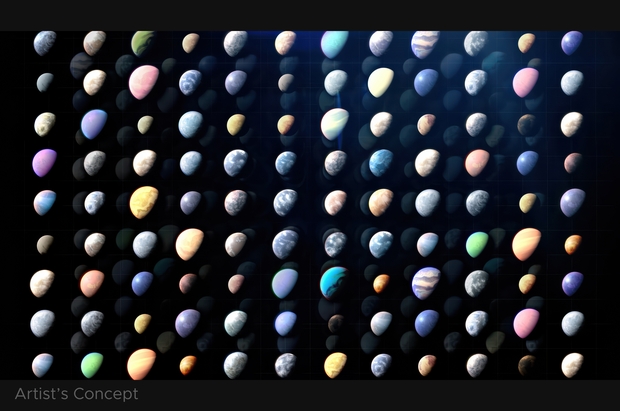
Image: Scientists have found thousands of exoplanets (planets outside our solar system) throughout the galaxy. Most can be studied only indirectly, but scientists know they vary widely, as depicted in this artist’s concept, from small, rocky worlds and gas giants to water-rich planets and those as hot as stars. Credit: NASA’s Goddard Space Flight Center.
The idea of a large and growing catalog of exoplanets is the kind of thing I used to dream about as a kid reading science fiction magazines. Now we’re on the cusp of biosignature detection capabilities via the deep study of exoplanet atmospheres. Fewer than a hundred exoplanets have been directly imaged, a number that is likewise expected to rise with the help of the Roman instrument’s coronagraph. With new tools to better block out the overwhelming glare of the host star, we’ll be seeing gas giants in Jupiter-like orbits. That in itself is interesting – how many exoplanet systems have gas giants in such positions? Thus far, the Solar System pattern is rarely replicated.
The Fortunes of K2-18b
The sheer variety of planetary systems brings even more zest to this work. Consider the planet K2-18b, so recently in the news as the home of a possible global ocean, and one with prospects for life given all the parameters studied by a team at the University of Cambridge. It’s a fabulous scenario, but now we have a new study that questions whether sub-Neptunes like this are actually dominated by water. Caroline Dorn (ETH Zurich), co-author of the paper appearing in The Astrophysical Journal, believes that water on sub-Neptunes is far more limited than we have been thinking.
Here’s another demonstration of how our Solar System is so unlike what we’re finding elsewhere. Lacking a sub-Neptune among our own planets, we’re learning now that such worlds – larger than Earth but smaller than Neptune and cloaked in a thick atmosphere abundant in hydrogen and helium – are relatively common in our galaxy as, for that matter, are higher density but smaller ‘super-Earths.’ A global ocean seems to make sense if a sub-Neptune formed well beyond the snowline and brought a robust inventory of ice with it as it migrated into the warmer inner system. Indeed, the term Hycean (pronounced HY-shun) has been proposed to label a sub-Neptune planet with a deep ocean under an atmosphere rich in hydrogen.
The new paper examines the chemical coupling between the planet’s atmosphere and interior, with the authors assuming an early stage of formation in which sub-Neptunes go through a period dominated by a magma ocean. The hydrogen atmosphere helps to maintain this phase for millions of years. And the problem is that magma oceans have implications for the water content available. Using computer simulations to model silicates and metals in the magma, the team studied the chemical interactions that ensue. Most H20 water molecules are destroyed, with hydrogen and oxygen bonding into metallic compounds and disappearing deep into the planet’s interior.
From the paper:
Our results, which focus on the initial (birth) population of sub-Neptunes with magma oceans, suggest that their water mass fractions are not primarily set by the accretion of icy pebbles during formation but by chemical equilibration between the primordial atmosphere and the molten interior. None of the planets in our model, regardless of their initial H2O content, retain more than 1.5 wt% water after chemical equilibration. This excludes the high water mass fractions (10–90 wt%) invoked by Hycean-world scenarios (N. Madhusudhan et al. 2021), even for planets that initially accreted up to 30% H2O by mass. These findings are consistent with recent studies suggesting that only a small amount of water can be produced or retained endogenously in sub-Neptunes and super-Earths.
The work analyzes 19 chemical reactions and 26 components across the range of metals, silicates and gases, with the core composed of both metal and silicate phases. A computer model known as New Generation Planetary Population Synthesis (NGPPS) combines planetary formation and evolution and meshes with code developed for global thermodynamics. Thus a population of sub-Neptunes with magma oceans is generated, and consistently primordial water is destroyed by chemical interactions.
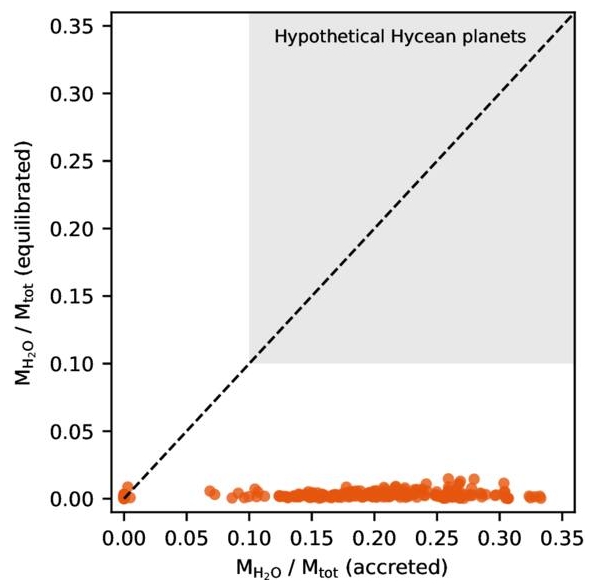
Image: This is Figure 3 from the paper. Caption: Envelope H2O mass fraction as a function of semimajor axis… The left panel shows planets that predominantly formed inside the water ice line; the right panel shows those that formed outside. Classification is based on the accreted H2O mass fraction, with a threshold set at 5% of the total planetary mass. The colorbar indicates the molar bulk C/O ratio. Planets formed inside the ice line are systematically depleted in carbon due to the lack of volatile ice accretion and exhibit higher envelope H2O mass fractions. In contrast, planets formed beyond the ice line retain lower H2O content despite higher bulk volatile abundances. Each pie chart shows the mean mass fraction of hydrogen in H2 (gas), H (metal), H2 (silicate), H2O (gas), and H2O (silicate), normalized to the total mean hydrogen inventory for each population. Only components contributing more than 5% are labeled. Planets that formed beyond the ice line store most hydrogen as H2 (gas) and H (metal), while those that formed inside the ice line retain a larger share of hydrogen in H (metal), H2 (silicate), and H2O (gas + silicate).. Credit: Werlen et al.
This is pretty stark reading if you’re fascinated with deep ocean scenarios. Here’s Dorn’s assessment:
“In the current study, we analysed how much water there is in total on these sub-Neptunes. According to the calculations, there are no distant worlds with massive layers of water where water makes up around 50 percent of the planet’s mass, as was previously thought. Hycean worlds with 10-90 percent water are therefore very unlikely.”
The paper is suggesting that we re-think what had seemed an obvious connection between planet formation beyond the snowline and water in the atmosphere. Instead, the interplay of magma ocean and atmosphere may deliver the verdict on the makeup of a planet. By this modeling, planets with atmospheres rich in water are more likely to have formed within the snowline. That leaves rocky worlds like Earth in the mix, but raises serious doubts about the viability of water in the sub-Neptune environment.
From the paper:
Counterintuitively, the planets with the most water-rich atmospheres are not those that accreted the most ice, but those that are depleted in hydrogen and carbon. These planets typically form inside the ice line and accrete less volatile-rich material. While some retain significant atmospheric H2O, the high-temperature miscibility of water and hydrogen likely prevents the presence of surface liquid water—even on these comparatively water-rich worlds.
This has broad implications for theories of planet formation and volatile evolution, as well as for interpreting exoplanet atmospheres in the era of the James Webb Space Telescope (JWST), the Extremely Large Telescope (ELT), ARIEL, the Habitable World Observatory (HWO), and the Large Interferometer for Exoplanets (LIFE). It also informs atmospheric composition priors in interior characterization of transiting planets observed by Kepler, TESS, CHEOPS, and PLATO with radial velocity (RV) or transit timing variation (TTV) constraints.
K2-18b will obviously receive continued deep study. But with an aggregate 14,000 exoplanets confirmed or listed as candidates, consider how overwhelmed our instruments are by sheer numbers. To do a deep dive into any one world demands the shrewdest calculations to find which exoplanets are most likely to reward the telescope time. This aspect of target selection will only get more critical as we proceed.
The paper is Werlen et al., “Sub-Neptunes Are Drier than They Seem: Rethinking the Origins of Water-rich Worlds,” Tje Astrophysical Journal Letters Vol. 991, No. 1 (18 September 2025), L16 (full text).


